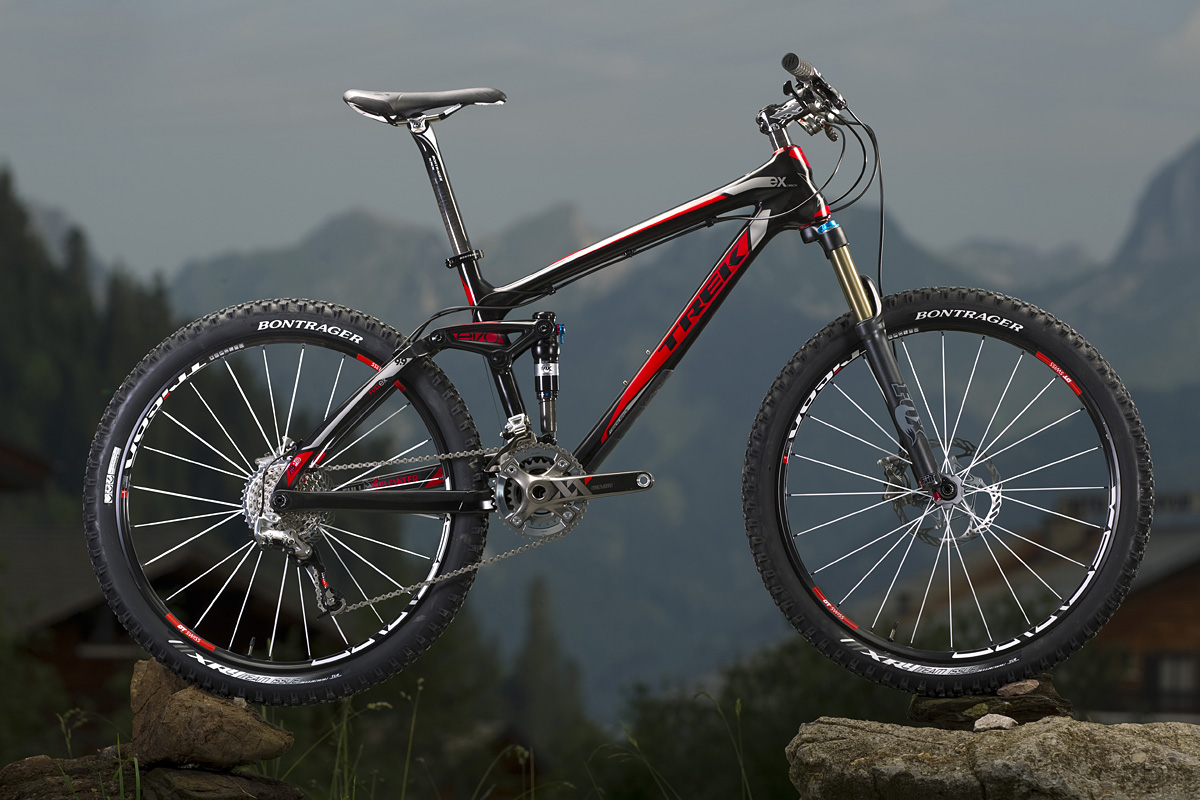Trek 2011
Last week we were fortunate enough to be asked to attend the Trek 2011 launch in Chatel in the French Alps. Three and a bit days of riding on great trails and four different bikes to test on very varied terrain. First of all 2011 Trek Fuel EX
Fuel EX.

The Fuel is Trek’s all round trail/XC Bike. 120 mm either end , seat angle 72.5 degrees and head angle 69 degrees so tried and tested angles .
Changes for this year are numerous, the main ones being the EX is full Carbon – So that includes the chainstays this year; according to the engineers at Trek, this is an incedibly difficult thing to do to make it strong enough and to fit into the original frame has taken a lot of time and engineering.

The frame material itself has also changed to Trek OCLV Mountain, this is a tougher version of their carbon technology with reinforcements at areas of repeated impact or greater loads, in this case the seatstays and lower half of the downtube.

Added to this is also Treks “Carbon Armour” which is a polymer shield (feels like rubber to me) attached to the downtube to further protect the frame.
Trek have invented a new standard to test for impacts on carbon using an anvil test to replicate a rock hitting the frame – interestingly a lot of micro-cracks that appear after repeated strikes don’t affect the frame’s integrity, but obviously aesthetically and psychologically can be very offputting for riders! The combined affect of the Carbon Armour and the OCLV Mountain frame technology should help remove that.
ABP CONVERT
Quick bit about existing ABP technology for those not aware.
I think that explains it far better than I ever could – But you get the idea. It keeps the bike active under braking,which leaves you in more control of the bike.

So ABP Convert is another upgrade at the back end of the EX, which converts the existing 135 mm QR to a 142mm 12mm through axle.
How does 142mm fit into 135mm? The 142mm is slighly misleading – It’s not some new hub width (well not in the case of Trek) but the measurement of the axle in totality – so the 142mm includes the threaded axle that runs into the ABP pivot hence the 142mm measurement. Convert is also backwards compatible (hence the name) so if you have a really light pair of spangly XC wheels which are traditonal QR you can carry on using them.
DRCV Rear Shock /Trek Custom Fork
Both the Fuel and the Remedy use the Trek-only DRCV shock. The best way to think of this is as two shocks but in one elongated canister – The inital part of the shock is basically the same as a standard RP23 shock so all of your small bumps and ripples are coped with here. As the shock moves into 50% of its travel, the second part of the shock opens (the part above the linkage and Pro-Pedal lever) and allows what is effectivley a larger volume air spring to take control of the bigger hits. As you return back into the inital part of the travel the second chamber closes and you’re back with a “normal” shock. This is all instantaneous in use and you can’t feel it transition between the smaller and larger volume whilst riding at all.


The Fox forks also have a custom tune to suit the rear shocks which involves custom shimming to match the rear. One thing that was made clear throughout the week was that Trek are looking for a balance with their suspension- rather than trying to fine tune one requirement of riding (be that better bump response or climbing ability) they’re looking at the suspension in totality – this includes not trying to make a bike with built in anti-squat through linkage design to their own proprietary shock valving.
The Ride
First things first – check your sizing. I’m 5’8 (after being stretched by a Physio) and found 18″ a far better fit than the 17.5″ which I would have assumed would be my size.Going up a size isn’t a problem as the standover is so good.
We got two rides on the Fuel. The first being a four-hour death slog on a 17.5″ frame. Up fire roads, down fire roads, across fire roads. It did give me a chance to hyperventilate with Gary Fisher as I pushed up rubble strewn gullies in 30 degree plus heat, so it wasn’t all bad but you get the idea.
Three things I could say from the first ride were these. Bloody hell it climbs well! Bontrager’s new saddles are at least 1000% more comfortable than they’ve ever been (you get a good idea after that much seated climbing) and I’m a bit of a grumpy sod if I don’t get singletrack at the top of endless fireroad climbs. It did give me a good chance to test its climbing ability and this bike put every pedal input into forward motion with or without Pro-Pedal on. During the (very) brief bit of singletrack during the XC ride the Fuel EX was excellent – massively stiff, it tracked incredibly well and you could thrash it through rocks as if it was a much bigger bike. It did leave me hankering for more technical riding on it, which I reckon is always a good sign.
I managed to grab a larger sized EX on Friday for a “photo shoot”. On went a 70mm stem and the steerer spacers flipped so the front end felt lower and we finally (thanks Geoff Waugh) escaped onto some singletrack.

The EX is fantastic on singletrack – incredible for such a light bike in fact. The combined effect of the ABP rear end the 15mm thru-axle fork must help, but the chassis is so stiff! The carbon also seems to do that clever but hard to describe damping thing – it’s a very, very quiet bike. I couldn’t help wondering whether this was partly down to the carbon armour also acting as a vibration damper – either way it made for a distinctly un-clattery ride. Suspension wise I ended up running quite a lot of low speed compression on the front with the pro-pedal on nearly all of the time. The acceleration was addictive and the small amount of small bump compliance lost by having firmer suspenion was more than made up for by whiplash effect out of corners. Honestly you could ride this down very hard stuff if you trusted the bike to do its thing and I started yearning for a big pair of wide bars to see how hard you could push it through corners. On the subject of cockpit, quick mention of Bonty’s new low rise bars – They are really very comfortable, have a really nice sweep and a pleasing 700mm (they weren’t that convinced by my suggestion of 750mm bars on a trail bike) width. You can see Trek has been looking outward at what’s going on in the world of riding and the cockpit is a reflection of this in much the same way the carbon armour is a tidier, more industrial version of the old tyres attached to the downtubes of bikes at bike parks.
Trek describe this as the ‘ultimate trail bike’. It’s also the type of bike that most riders in the UK will need or want. Very nice!
More tomorrow






Nice. Suspension travel, prices and availability info, please.
supposed to be 6k….. for a Trek….( and that comes from a Trek.. owner.)
[quote]which is a polymer shield (feels like rubber to me)[/quote]
Maybe that’s because rubber is a polymer maybe?
Exactly! ;] Must try to convey Tonal inflection better
Geometry? Particularly head angle…any change over the 2010?
Hi Mark – I’m waiting for Trek to send Geometry tables – I’ll update the story the moment I get them ;]
Very nice looking frame.
Are you stuck with the custom shock or can you fit a normal one with a spacer or something?
Ooh nice but is it me or does the first pic look like an catalogue advert from the 70s for an Action Man vehicle?
Lol I agree drac
Why would you want to change the shock? The DRCV shocks are by far the best
Yes it is £6k for a Trek but for that you are getting a state of the art U.S. handmade carbon fibre frame with custom shock and forks, Sram XX groupsetand DT Swiss Tricon wheels and carbon parts everywhere so a little dificult to get higher spec. That level carbon frame would be £2300-2500 at least so add up the parts and it would be more than £6k.
Everyone will have to adjust to prices being 10-15% higher for 2011.
Why would you want to change the shock? The DRCV shocks are by far the best
I don’t doubt that, I’m more thinking of getting a replacement in the future should it fail.
and the 29er version is tomorrow then?………:-(
“Everyone will have to adjust to prices being 10-15% higher for 2011.”
I thought this is what manufacturers and distributors said in 2009 about 2010?
“Everyone will have to adjust to prices being 10-15% higher for 2011.”
I can’t help thinking that the big bike companies know that the type of person who buys a 5k or 6K ( or even 3 or 4K) bike are actually not affected by the recession or bothered by commodity price rises. Trek know that they can sell this stuff to a certain buyer and an extra £500 per year makes no difference to them….
Fair enough to Trek if they can sell it…but to say this is down to commodity prices or exchange rates is nonsense IMO. It’s a product strategy. They chose the price point before they specced the bike.
Well lets see, shipping costs on a container have gone up from approx $1500 to about $4000 this year. Labour costs are increasing in the far east as their living standards improve, raw materials costs are increasing across the board, Shimano’s prices have increased due to weakness of the Yen and increased raw material costs. The £ has got weaker against the $ which is the main currency international trade is done in. All this does indeed explain the increases, just look at how new car prices have increased in the last year or two. Shimano have stated they are at full capcity and have no intention of expanding.
Yes we had price increases in 2010 from 2009 and this is a continuation of the same thing. Prices were getting cheaper and cheaper for about 10 years and now they’re going back up to where they probably should have been if it weren’t for the artificially inflated value of the £.
There is lots of competition in the bike trade to keep prices down, more than they probably actually need to Margins are very very tight in the bike industry so companies don’t have the room to absorb huge increases in costs. If you operated on a 5% margin would you absorb a 10% increase in costs when you were selling everything you could make?
trek have invested loads in R&D in the past 5 years and they deserve to reap the rewards through reduced price elasticity of their brand and increased sales. They are producing probably the strongest range in the industry with truly class leading technology so good on them.
Lots of people love to feel they are being ripped off when they can’t afford things but manufacturers simply can’t afford to do it in such a competitive industry. If Trek were overcharging by so much load of their potential customers would go and buy a Specialized or a Giant or similar.
It isn’t just the top end bikes that are increasing by so much, it’s the mid range too. Entry level bikes are affected more due to shipping costs and labour costs proportionally being even higher per unit in relation to value.
Why would you want to change the shock? The DRCV shocks are by far the best
“I don’t doubt that, I’m more thinking of getting a replacement in the future should it fail.”
A fox shock experiencing a total failure? Interesting idea. Fox carry all parts for servicing and warranty so not a problem, servicing is usual parts so no problem.
So…Trek only produce a 6k bike because things just got so gosh darn expensive ? Nothing to do with product strategy…?
Sorry I don’t buy it (quite literally). But like I said “fair enough to Trek if they can sell it…”
A fox shock experiencing a total failure? Interesting idea. Fox carry all parts for servicing and warranty so not a problem, servicing is usual parts so no problem.
And how long are Fox going to keep making spares for it after Trek gets bored of this design? Are you going to be able to get hold of a rebuild kit from your LBS when it goes wrong a day before you’re due to take it on holiday?
But anyway, I was only wondering. A reasonable question I thought! 😛
“Fox carry all parts for servicing”
Once you’ve forked out for a service plus a few siginificant parts its wouldn’t be unlikley that you could find something somewhere well below RRP that would work out costing less. If something else (albeit less advanced/complex) will fit then it’d be nice to know
The shock uses same rebuild kit as regular air can.
I’m afraid these arguments seem very weak and the same could be applied to Brain shocks used on Specialiized bikes for years and thats not proven to be a problem.
If it’s a case of being tight and wanting to replace it with a cheaper 2nd hand unit if it dies then that may be harder but i struggle to sympathise. With these attitudes there would never be any innovation and progress.